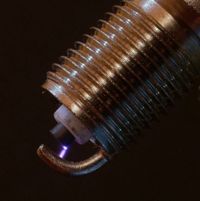
Photo from wikipedia
This work discusses the damage and failure effect of a hydraulic electric pulse and the law of crack growth on coal. The impact and failure effect of a water shock… Click to show full abstract
This work discusses the damage and failure effect of a hydraulic electric pulse and the law of crack growth on coal. The impact and failure effect of a water shock wave and the mechanism of crack initiation, propagation, and arrest were studied by numerical simulation and the fracturing test of coal, combined with CT scanning, PCAS software, and Mimics 3D reconstruction technology. The results show that a high voltage electric pulse that increases permeability is an effective artificial crack making technology. The crack spreads radially along the borehole, and the damage degree, number, and complexity were positively correlated with the discharge voltage and discharge times. The crack area, volume, damage factor, and other parameters increased steadily. The cracks in the coal first start from two symmetrical angles, and finally distribute in a 360 deg circumferential direction, forming a multiangle crack spatial network structure. The fractal dimension of the crack group increases, the number of microcracks and the roughness of the crack group increases, the overall fractal dimension of the specimen decreases, and the roughness between cracks weakens. The cracks then form a smooth coal-bed methane migration channel. The research results can provide some theoretical guidance for the evaluation of crack damage propagation and the effect of electric pulse fracturing in water.
Journal Title: ACS Omega
Year Published: 2023
Link to full text (if available)
Share on Social Media: Sign Up to like & get
recommendations!